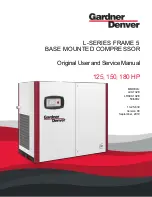
12
AGL_AC_ST_YRH_EN_Rev01
permanently plugged with normal system debris and block the flow of either oil or refrigerant to the
compressor. Such blockage can result in compressor failure.
3.11 Compressor oil return, oil balancing, refrigerant floodback and oil dilution tests
CAUTION
Inadequate lubrication! Bearing and moving parts destruction!
Ensure
adequate oil return from the system into the compressor at any time. No liquid
refrigerant should return to the compressor. Liquid refrigerant dilutes the oil,
could wash the oil off the bearings and moving parts and could lead to
overheating and compressor failure.
The system piping must be carefully designed to ensure sufficient refrigerant gas velocity, so that oil
returns to the compressor at all times and conditions. Individual piping diameter calculation depends
on the refrigerant properties, pressure level, mass flow, and density.
Once a new system design is set and assembled, a functional test is required. The functional test
includes a qualification for the general system oil return, a refrigerant floodback test and an oil dilution
test.
A sample compressor equipped with an external oil sight tube can be ordered from Emerson for lab
testing.
Records of the evaporating temperature and the bottom shell temperature shall be taken with a high
sampling rate during the entire oil return or oil balance testing and under all tested conditions. The
liquid level in the sight tube has to be observed and recorded too. Testing conditions shall include
the different operation modes and varying loads. If the system is reversible, tests should be
conducted in cooling, heating and defrost modes.
System engineers should review the system design and operation to identify the critical conditions
and to check oil return, oil balancing, liquid floodback and oil dilution. To assess individual test results
and system behaviour, eg, with regard to oil dilution, please contact the Application Engineering
department. Typically, the following situations should be considered:
▪
general oil return test:
testing conditions shall be at full and minimum mass flow and density of
suction gas in continuous and frequent start-stop cycling.
▪
liquid floodback and oil dilution test:
all possible transient operation conditions in the system
should be checked, eg, compressor frequent start/stop, compressor start after long off time with
migration, defrost, switching between the operation modes in reversible systems, load changes,
fans or pumps cycling at low load and more. To evaluate the risk of liquid floodback or oil dilution,
please refer to the charts in
Figures 11 & 12
. The bottom shell temperature of the compressor
and the evaporating temperature have to be monitored.
* tb = = bottom shell temperature; te = evaporating temperature
Figure 11: Oil dilution chart R454C
Figure 12: Oil dilution chart R290
The bottom shell temperature together with the evaporating temperature gives an indication whether
liquid refrigerant is returning or diluted in the compressor oil sump. The compressor sump
temperature must remain in the (green) safe area, as shown in the charts in
Figures 11 & 12
. In
case of operation in the (red) unsafe area, adjustments are required in order to modify the system
design, refrigerant charge or superheat setting of the expansion device(s). The bottom shell
temperature should be measured accurately. The thermo-probe must be properly insulated and
positioned on the lower side of the compressor shell.
















































